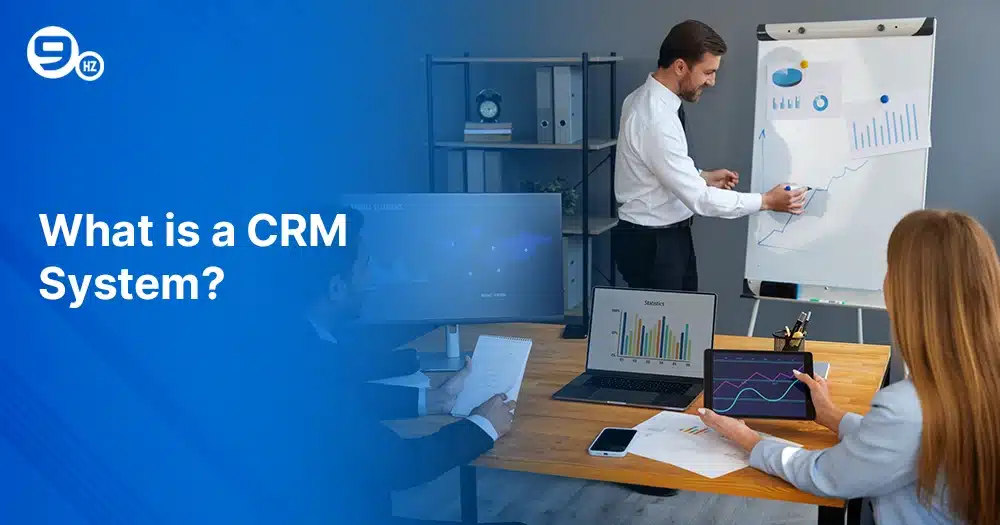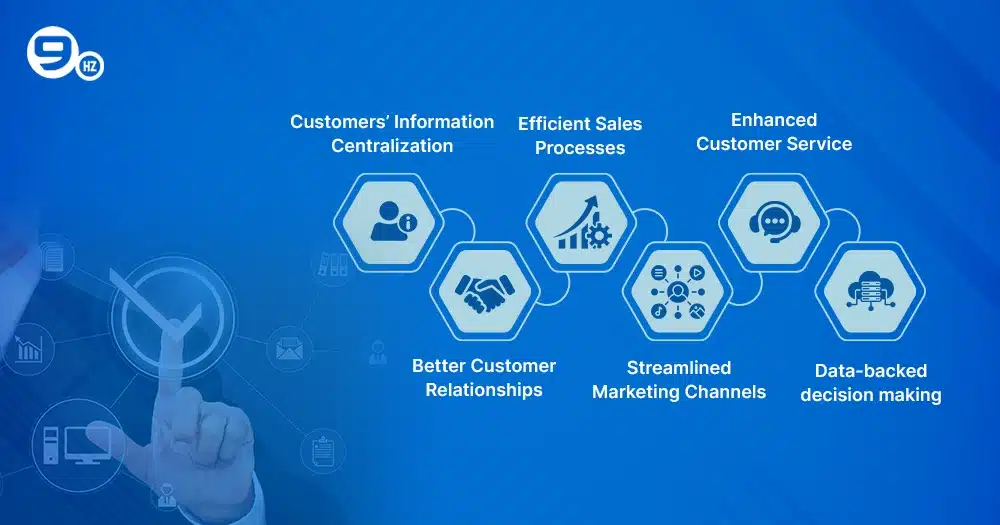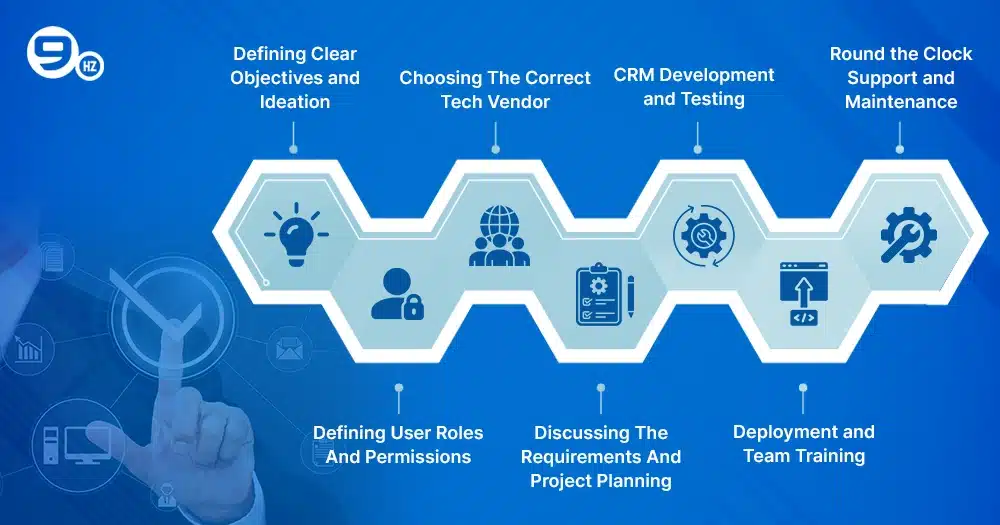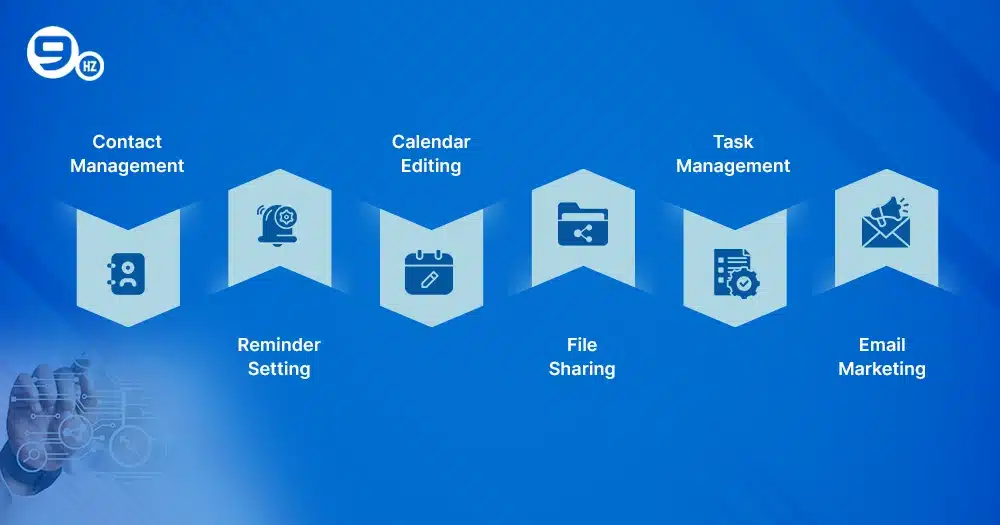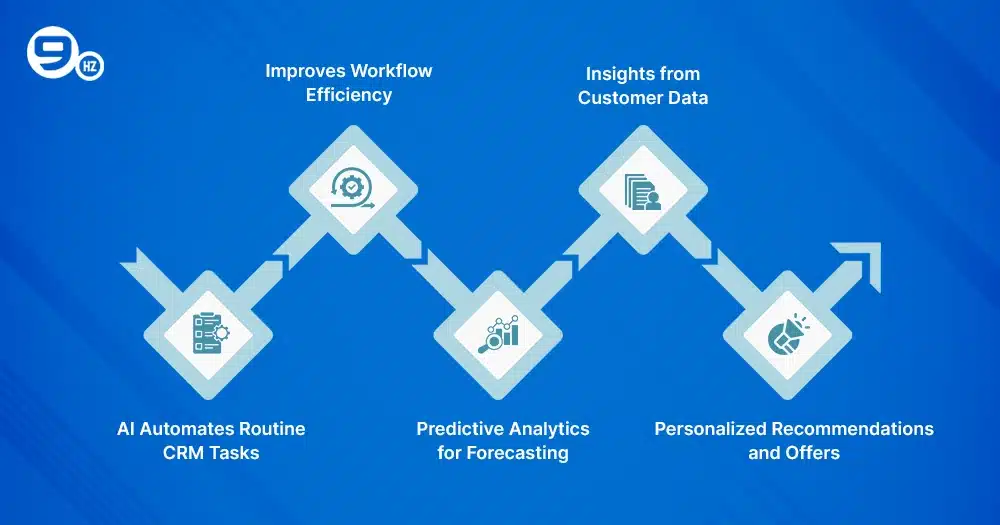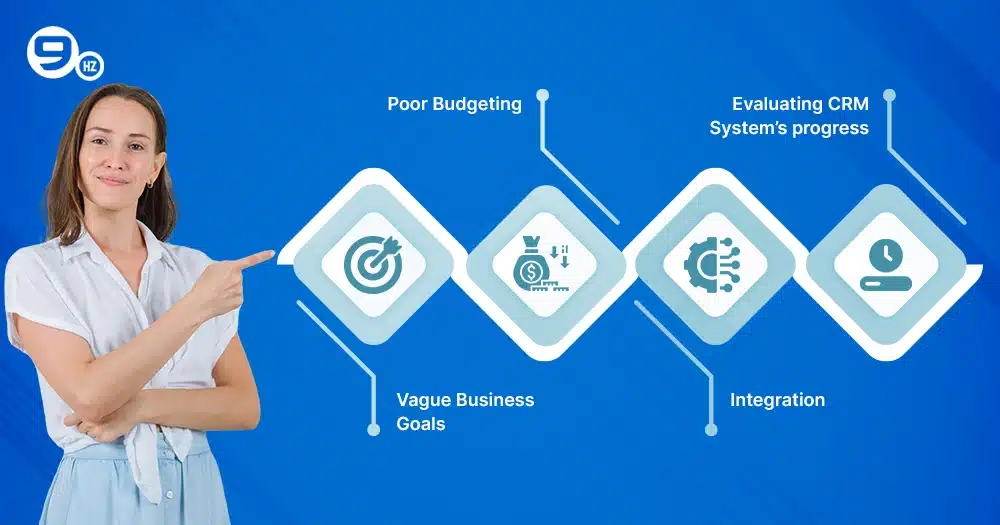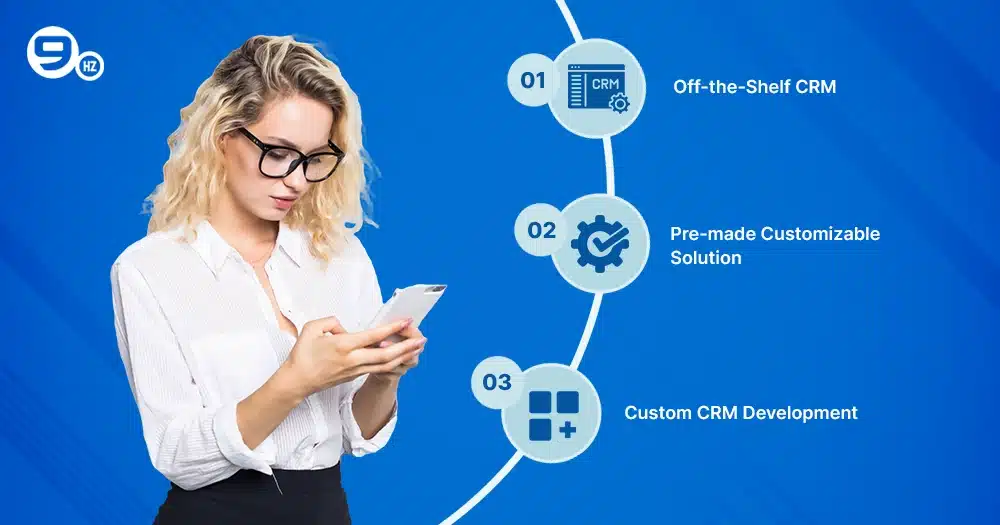Being a business owner, you must be familiar with most of the trending CRM solutions. For most companies, CRM Software Development Company is a must as it helps them keep, access, and manage critical sales data efficiently. However, If you need a solution that fits your business perfectly, you can build your own CRM. A custom CRM enables you to close sales faster, produce more leads, and strategically manage customers’ information, giving you a competitive edge.
According to Statista, The Customer Relationship Management (CRM) software market is projected to reach $89.03 billion in 2024, with a steady annual growth rate of 10.34%, hitting $145.60 billion by 2029. So, the current time is ideal for any company to leverage this early mover advantage in the CRM market which is highly rewarding.
This article will shed light on how to build a CRM system from scratch including its features, development steps, and critical considerations. Additionally, we’ll explore the key cost factors in developing CRM software and offer expert tips on how to choose the right software development company. We’ll also share valuable insights on how to hire the perfect CRM developer. With that, let’s dive right in!
What is a CRM System?
Before knowing the process to create your own CRM system, let’s get comfortable with knowing what a CRM actually is. A Customer Relationship Management System (CRM) is a multilayered tool that is used by companies when it comes to scrutinizing clients’ interactions and measuring data throughout the customer lifecycle.
By utilizing databases, CRM gathers and examines valuable client-related data. Hence when it comes to managing customers efficiently, CRM is possibly the most common way. So, you must consider how to create a custom CRM system for your business.
CRM software helps strengthen business relationships with customers through retention and acquisition. So, if you are a large multinational looking to manage client interactions or a small startup looking to store information and make it accessible across multiple devices, CRM tools can be leveraged in both scenarios.
CRM Market Share Statistics
- According to Statista, the United States will generate the highest revenue in the Customer Relationship Management Software market, reaching US$45,110.00m in 2024.
- As per reports, Mobile CRM systems are used by 65% of sales professionals, whereas non-mobile CRM systems are used by only 22% of sales professionals.
- Across industries, 91% of companies with over 10 employees now use a CRM system.
- Customer relationship management systems can boost customer loyalty and revenue by up to 27% by improving customer retention rates.
- The market share of cloud-based CRM systems is more than 87%. It provides easier remote access for global teams.
Related Articles
Top 20 CRM Software Development Companies in 2024
20 Best CRM Software
Why Does Your Company Need CRM Software?
Prioritizing customer experience is the best way to multiply sales and retain customers. There are multiple benefits of installing Customer Relationship Management Software within your company that lead to enhancing various aspects of its operations and customer interactions.
Here are 6 Benefits of Developing a CRM System:
Customers’ Information Centralization
- Improved Accessibility: Across different departments, team members can access the latest information fostering better collaboration and informed decision-making.
- Unified Database: All customer relation information like contact details, interaction history, choices, and preferences can be stored in a single centralized system.
Better Customer Relationships
- Tailored Interactions: With CRM systems, businesses can alter their communication channels and provide offers based on customers’ preferences and information.
- Timely Follow-ups: With the help of automated reminders and alerts, you can ensure that no customer inquiries and follow-ups are missed.
Efficient Sales Processes
- Sales Forecasting: A company can better analyze recent trends to anticipate future sales, enabling better strategic planning and resource allocation.
- Sales Pipeline Management: Track leads throughout the sales funnel lifecycle to identify loopholes and scope for improvement.
Streamlined Marketing Channels
- Automation in Marketing: Marketing Automation helps in automating repetitive tasks to bring efficiency and enhance overall productivity.
- Targeted Campaigns:By choosing to develop your own CRM, you can plan effective marketing campaigns by segmenting customers based on their demographics, behavior, and preferences.
Enhanced Customer Service
- Knowledge-driven Integration: When customer service executives get the necessary information and data related to customers, they can provide better and quicker responses, leading to increased customer satisfaction.
- Efficient Support Management: Tracking and managing customer support tickets ensures timely resolution of issues.
Data-backed Decision Making
- Sound Strategy Making: Explore new opportunities for growth by using data insights to revitalize business strategies and optimize processes by building a CRM system.
- Comprehensive Analytics: Detailed reports and dashboards help in providing valuable insights into sales performance and customer behavior.
How to Build a CRM System from Scratch?
If you want to streamline your business operations, enhance your customer interaction, and drive growth, then creating a customer relationship management software (CRM) tailored to your business needs is the best decision that you can make. You need precise planning, collaboration, and execution in order to develop a system like CRM from scratch. Let’s have a close look at the main CRM development stages and learn how to develop such a system from scratch:
Step 1: Defining Clear Objectives and Ideation
Laying the foundational structure
The stage involves drafting a detailed CRM implementation plan that includes the business goals you want to achieve and the challenges you have to deal with. This fundamental step ensures that the CRM aligns with your business goals and addresses specific challenges.
- Identify Business Needs: Determine the primary issues you want the CRM to solve. Common objectives include enhancing customer retention, improving sales tracking, or streamlining customer support.
- Set Precise Goals: Setting smart and clear goals will always give you an edge. Make sure the goals are realistic and time-bound so that the execution can be done properly and progress can be tracked.
- Team Members Engagement: Encourage engagement of your team members (like sales, customer support, IT) to promote creativity and ensure the CRM addresses the needs of all users.
- Outline Primary Features: Depending on your goals, write down the essential functionalities to be integrated into your application. This includes marketing automation, sales management, reporting and analytics, task management, lead management, etc.
- Strategic Analysis: Study the existing CRM systems to understand the industry standards and identify gaps for better team management.
The well-structured business goals will assist the CRM development team in making a detailed roadmap and choosing the most ideal technology stack. On top of that, a clear plan will accelerate the development process and reduce the overall cost of developing a CRM.
Step 2: Defining User Roles And Permissions
Ensuring complete access and high functionality
CRM platforms can establish robust communication channels among employees, promoting better collaboration and productivity. However, based on individual requirements, each team member utilizes the CRM software differently.
For example, the Sales department utilizes CRM for lead management and automation, the marketing department for campaign tracking and audience segmentation, and the customer support department for assessing customer interactions and managing service tickets.
- Categorizing Users: Identify user types based on their roles within the company such as technical executives, marketing managers, customer support executives, etc.
- Determining Access Levels: Define user roles in terms of editing, viewing, deleting, or creating within the CRM. For example, the sales department has access to lead information, while managers have access to generate reports and monitor team performance.
- Security Protocols: Protect sensitive customer data via data encryption, and timely security audits by implementing robust security measures.
- User Experience Considerations: Make sure the interface and added functionalities help in reducing the clutter and enhance productivity.
- Customization Flexibility: As the organization evolves and new roles emerge, design the system to allow easy modification of roles and permissions.
Hence, a CRM will be leveraged by various team members each with different roles and responsibilities. Specifying the team for which you are creating the CRM is crucial as it ensures the unique needs of each department are met without any difficulty.
Step 3: Choosing The Correct Tech Vendor
Picking the right partner based on expertise and compatibility
Building a CRM from scratch in a speedy manner is only possible by outsourcing the development to an IT vendor with proven expertise in custom CRM development services. Outsourcing the right vendor will let you avail of premium class service in exchange for a nominal price.
- Evaluate Technical Expertise: Choose a technology partner with a proven track record in building CRM systems or similar enterprise software. Expertise in technologies like cloud computing, database management, and API integration is highly recommended.
- Years of Experience: Look for partners having experience in your specific industry. This will help you better understand your individual requirements and challenges.
- References and Portfolio: Review your technology partner’s past projects and work to judge their credibility. Consider going through the testimonials and references from previous clients to assess their quality of work.
- Ease of Communication: Vendors with strong communication skills and a collaborative approach are highly desirable. Effortless communication is essential when it comes to translating requirements into a functional CRM.
- Pricing: Only choose your partner after ensuring that the cost aligns with your budget. Make sure that there are no hidden costs or additional charges and that the company maintains complete transparency.
Build your own CRM software correctly by researching your potential vendor in-depth—from the company’s portfolio, expertise, and experience to client reviews on reputable B2B platforms like Clutch. Partnering with the right vendor will make things way too easy for you and help you build your system effortlessly.
Step 4: Discussing The Requirements And Project Planning
Mapping your CRM
Here, the bulk of the work shifts to your software development team. It starts with analyzing your requirements followed by converting your vision into a comprehensive feature set customized for your operations.
Under this step, your technology partner works closely with you to outline both functional and non-functional requirements. They also present a detailed project timeline with clear milestones, allowing you to monitor progress and stay up to date.
- Functional Requirements: Define the essential features and functionalities to be integrated into your CRM. This includes lead tracking, sales forecasting, analytics, and marketing automation.
- Non-Functional Requirements: Define performance criteria, that include security standards, scalability, and compliance.
- Workflow Mapping: Outline the processes prevailing in the organization and figure out how they will be improved or integrated within the CRM.
- Wireframes and Prototypes: Based on the user experience, create visual representations of the CRM’s user interface. For early user testing and feedback, we build prototypes, while wireframes are used to visualize the layout and navigation.
- Project Timeline and Milestones: Defining a realistic timeline with clear milestones always helps in outlining the feasibility and profitability of the project.
- Risk Analysis: Always assess the potential risk associated with your project and develop mitigation strategies as they are essential while addressing the challenges that might occur during development.
You review the plans and give feedback to make sure the project remains on the right track. This collective approach with your IT vendor launches a rock-solid foundation for the development phase, setting the stage for a tailored and robust CRM system.
Step 5: CRM Development and Testing
A robust system in the making
The development team builds the CRM software based on detailed user stories prepared by the business analyst after defining the project’s scope. As soon as the scope is defined, the development phase begins, involving crafting your CRM through coding, configuration, and iterative testing to make sure it’s sturdy, intuitive, scalable, and fully secured.
- Agile Methodology: Adopt agile development strategies and bring flexibility and timely improvements based on feedback.
- Front-end Development: Involves designing an eye-catching and intuitive user interface developed with best front-end practices and supports effortless navigation.
- Backend Development: Use the latest tech stack and in-demand frameworks to build a robust backend that performs data management effortlessly by adhering to security standards.
- Feature Implementation: Develop previously defined core features of the CRM like marketing automation, sales pipeline, and analytics.
- QA and Testing: Perform in-depth testing at each development stage to identify all the bugs and errors to ultimately rectify those flaws and vulnerabilities. Types of testing include unit testing, system testing, integration testing, and user-acceptance testing.
During development, quality assurance engineers systematically test both backend and frontend functionalities to identify and address any issues that may occur. Continuous feedback ensures the CRM system stays aligned with your objectives.
Step 6: Deployment and Team Training
Launching Successfully
Developers ensure successful deployment of the CRM and seamless use by end users. It marks the transition from development to operational use. Proper deployment and training ensure seamless integration of the CRM into your business operations so that the team is fully equipped to use it.
- Development Environment: Choosing the development environment involves deciding whether to go for cloud-based CRM or host on-premise CRM based on accessibility, cost, and scalability.
- Data Migration: Involves carefully transferring existing customer data into the new CRM. Optimize the data and eliminate outdated information before final migration.
- Pilot Testing: Within a controlled environment, launch the CRM with a small group of users to spot any loopholes by gathering valuable feedback.
- Full-scale Deployment: Once pilot testing is successfully done and all issues have been addressed, roll out the CRM to the entire enterprise.
- Training and Workshops: This involves conducting regular training and workshops to equip the workforce with the software. This helps in gaining hands-on experience and addressing common issues.
In the end, it is vital to prepare your team for the transition by communicating the benefits of the new Customer Relationship Management System and convincing them why it is pivotal to the success of your company.
Step 7: Round the Clock Support and Maintenance
Vital for long-term success and relevance
A CRM demands regular support and maintenance in order to stay relevant and effective. It ensures the CRM remains effective by aligning it with the evolving business needs. This ongoing support is very helpful when it comes to ensuring the CRM adapts to changes and keeps providing value.
- Dedicated Support Systems: Set up dedicated support channels including ticketing systems, help desks, or direct contacts with your tech partner to address users’ issues and queries.
- Timely Updates: Implement new features and fix existing vulnerabilities to ensure the smooth functioning of the software. Always stay informed about technological advancements to have an edge over your competitors.
- Regular Feedback: Collect timely feedback from your users and try to get into their shoes to understand what changes can be made to transform the user experience.
- Performance Monitoring: Performance monitoring helps identify and address bottlenecks, vulnerabilities, and loopholes that affect the performance of your system.
- Data Recovery and Backup: Implementing effective data backup techniques for preventing data leakage always helps in business feasibility in case of system failures.
Building a custom CRM system by following the right approach can significantly benefit you by fulfilling your business needs. These detailed steps can help you define clear goals and select the right technology partner. We hope these steps have helped you land on the right platform.
We, as a renowned tech company, also offer CRM system development services at affordable prices. Our unmatched services help us maintain our customer retention rate. Get in touch with our consultant and kick-start your project by partnering with a team that never compromises on quality.
Additional Features To Integrate Into Your CRM
Consider implementing these features in your CRM and optimize your business processes with better efficiency and productivity.
- Contact Management: Contact management helps in storing and optimizing customer information. This includes retrieving customer data in one centralized location. With Contact management, business enterprises can easily create and maintain comprehensive profiles for customers, leads, and vendors. Additionally, segmentation of contacts based on demographics, interests, and behaviors can also be done.
- Reminder Setting: By setting alerts, this reminder feature helps users stay on top of important tasks. This includes important meetings, deadlines, or customer engagements. Automated notifications never let you miss any deadline or opportunity, improving overall productivity and responsiveness.
- Calendar Editing: Calendar editing is a great way to schedule, manage, and modify meetings and events directly within the CRM. This helps in increasing collaboration within the teams with easy access to shared calendars, promoting streamlined business operations.
- File Sharing: The file sharing feature helps in keeping all your documentation in one place. Additionally, it lets you create a CRM for various departments. Further, access levels can be set to prevent employees from seeing files that are private and confidential. The system can also register all records of working with files.
- Task Management: With task management, users can easily create, assign, and track tasks across teams and departments. It brings accountability by allowing users to set due dates and assign tasks to members of the team, ensuring clarity. Teams can stay organized and focused by monitoring task completion via CRM.
- Email Marketing: Integrating with the email system helps in communication tracking. This includes allowing users to design, execute, and monitor email campaigns directly within the CRM software. Business enterprises can utilize the customer data and send targeted emails to generate leads.
Role of AI in CRM
Artificial Intelligence (AI) within a CRM system is the bedrock of automating routine tasks like lead management, data entry, and client segmentation. This includes streamlining workflows, allowing teams to focus on strategic tasks such as relationship building while improving efficiency and reducing human errors.
Predictive analytics backed by AI assists CRM software in forecasting customer behavior, enabling businesses to anticipate what’s next and take action. The real job of integrating AI within a CRM lies in providing insights into buying patterns by analyzing customers’ information and data, allowing for more informed decision-making.
With more personalization options, AI is proving to be a game changer within a CRM. This allows business units to customize interactions and marketing efforts to individual customers. AI analyzes data and based on that it predicts personalized recommendations, targeted offers, and deals, all leading to enhanced customer satisfaction and retention.
How Much Does It Cost to Build a CRM System from Scratch?
In this segment, we’ll talk about the cost required to build a CRM for your company. Majorly, the custom CRM development cost depends on the number of features you want to integrate and the level of complexity of your project.
Keeping the development aside, other expenses like quality assurance and project management also take place. This is equivalent to around 15-30% of the total CRM Software Development cost.
That said, hiring a team of developers, testers, designers, and project managers will help you save a lot of your hard-earned money and valuable time. It avoids a lot of rework and helps in bringing workflow automation.
Depending on your team’s location and expertise, the cost can vary. For example, the cost of hiring a development team in a sub-continent like India is way more affordable compared to hiring a team based in the United States.
Generally, the cost to develop a custom CRM solution may start from $25,000 and reach up to $200,000 or more depending on your project. We, at The NineHertz, make sure that your budget is not overstretched, and our competitive prices provide you good value for money.
CRM System Challenges
Facing challenges is unavoidable, especially when it comes to building a custom CRM solution. Here are some of the major challenges that might occur while designing a custom CRM solution:
1. Vague Business Goals
The purpose of creating a CRM must be clear in your mind. If the purpose isn’t clear, you might face trouble specifying the features you need, and your CRM may fail to meet your specific business requirements, hence proving to be ineffective.
2. Poor Budgeting
Budget allocation should be done after considering all the factors associated with the project. In CRM Software Development, poor budgeting can lead to resource shortages, delays, and below-average quality, ultimately risking the success of the project.
3. Integration
You may face challenges while integrating a new CRM system with current software and tools. Challenges in the areas of data migration and compatibility might occur frequently. Testing during the development phase is critical to address these issues.
4. Evaluating CRM System’s Progress
Due to its subjective nature, assessing the success of a custom CRM is mostly tricky. In the absence of a clear timeframe for success or failure, you’re likely to face some resistance to change from others. Emphasizing the primary characteristics like work speed, security, analytics, and integration can fix this issue.
Different Types of CRM Solutions: Off-the-Shelf, Pre-made Customizable, and Custom CRM
CRM comes in three forms – Off-the-shelf CRM platform, Customizable CRM, and Custom CRM. Let’s break them down one by one:
Off-the-shelf CRM Platform
This ready-to-use CRM system can be implemented immediately in just three simple steps: choosing a pricing plan, accessing the platform, and ultimately organizing a training session for your team. The downside is you might not be able to use some of its features. Additionally, since the pricing is done as per the number of seats, having a large team will make you pay a huge chunk of money. Another factor is scalability, since most platforms limit the storage space. The search to find the right CRM only remains until you find an off-the-shelf CRM that meets your business requirements and solves your daily tasks efficiently.
Pre-made Customizable Solution
This pre-made infrastructure lets you add multiple modules and change workflows according to your preference. Setting it up is much faster, and it can be tailored to your business requirements. For updates, you don’t have to worry at all since the vendor is responsible. The cost grows with every new user, and adding features is restricted to a pre-defined limit. Apart from that, if you have no technical expertise, then you have to avail services from a developer as building a feature requires fundamental technical knowledge. This particular option is ideal when you need a fast launch with a low development cost and most of the provided customization is helpful for your business.
Custom CRM Development
You can tailor a custom solution to suit your business workflows and integrate it easily with the other tools you are already using. It is highly flexible and secured as you get to choose the protection mode and, on top of it, no need to pay any additional cost while adding more users. However, CRM can be used only after paying for development. Additionally, it is a time-consuming task and, at a certain point, you will need tech services from a specialist in order to maintain the platform. It’s thus a good idea to think about how to build a CRM system from scratch, especially if you have a unique functional requirement and are willing to invest resources in custom CRM development.
How The NineHertz Can Help You Build Your Own CRM?
We are a team of efficient and proficient CRM software developers offering 360-degree software development services to businesses across all major verticals. As a power IT unit, The NineHertz specializes in numerous departments including research, design, development, deployment, and support.
We are well-versed in building custom CRM solutions as this is one of our main fortes. A couple of years ago, we helped a Tours and Travels Company famous for its diverse range of travel-related offerings develop a CRM system. During the pandemic, the tourism industry took a massive dip (both domestic and international) and so did our client.
Post-pandemic, the situation improved and inquiries started floating in for our client. Customers started demanding tailored trips leading to the need for a robust system for managing customer-related data and streamlining all processes. The company started facing inefficiency due to handling bulk data through manual entries.
We provided them with a custom CRM solution that gave them a 360-degree view of their clients’ database including crucial details like addresses, names, booking history, and more. This way, travel agents could efficiently manage customer accounts and handle bookings, which led to saving a lot of valuable time and resources.
Therefore, it is quite evident that we know the nitty-gritty of the CRM development lifecycle as we have delivered successful results in the past and made our customers happy. Get in touch with our consultants and discuss your requirements to get a tailored roadmap for your dream project.
Conclusion
In the end, a premium quality CRM built from scratch under expert guidance can become the soul of your business. Now that you know the process of creating CRM software, you can build a solution that provides a good return on investment (ROI) in the long run.
But what does it take to craft a system that takes the performance of your business to the next level? For that, the foremost step is to define the purpose and ultimate goal of your business. Then, partnering with a custom CRM development company can help you develop your idea into a working product.
At The NineHertz, we offer 360-degree custom CRM development services, helping clients with market research, ideation, validating, and lastly implementing their ideas into reality.
Frequently Asked Questions (FAQs)
How Hard Is It to Build a CRM?
Having a non-tech background is usually a limitation when it comes to building a CRM. It requires investing your time and resources, which could affect the profits of your business. Due to this, choosing a customizable CRM that lets your company personalize the solution without starting from scratch is the best option.
Why Should I Build a Custom CRM Instead of Using an Off-The-Shelf Solution?
A custom CRM is better when it comes to supporting omnichannel customer interactions. Bigger businesses have larger data processing demands, and with a larger customer base, they may rely on predictive analytics models that are not available in off-the-shelf CRMs.
What Are the Essential Features of A Custom CRM System?
Customer Support Ticketing System, Marketing Automation, Mobile Accessibility, Task Management, Opportunity Management, Reporting, and Analytics are some of the core features of a Custom CRM System.
How Long Does It Take to Build a Custom CRM System?
To build a CRM system, it takes anywhere from three to ten months. Some CRMs may even take 12 months or more to develop depending on the size and scope of your project. CRM modules can be developed incrementally, allowing you to implement and benefit from specific features as they become ready. This means your sales team, for instance, might start using the sales module within the first five months, even while the marketing and support modules are still under development.
What Technology Stack Is Best for Building a Custom CRM?
MEAN Stack (MongoDB, Express, AngularJS, and Node) is generally considered the best stack you can use to craft a highly scalable Customer Relationship Management Software. This tech stack is loaded with advanced technologies allowing you to develop cross-platform software with compact codes, faster execution, and excellent data storage.
How Do I Evaluate Different Technology Options Based on Factors Like Scalability, Maintainability, and Cost?
While evaluating technology options, consider factors like maintainability, scalability, and cost. Here’s a breakdown of how to analyze these elements:
- Scalability: Consider how technology can complement the growth of your business. Look for flexibility, optimum performance, and the ability to scale up your business.
- Maintainability: Analyze the characteristics and features of the technology. Maintaining a simpler system with good documentation and a strong community is easy.
- Cost: Consider pricing factors like upfront costs, cost of ownership, ongoing expenses, and hidden costs. If your technology aligns with your budget and business goals, you are good to go.
How to Build a CRM System from Scratch?
If you want to build a CRM system, you will have to go through some steps. First You will have to decide what kind of software you want, what features you want to have in your software. Once you decide about the software, you will have to decide what tech stack you want to use to build the CRM system. Then, you will have to invest your time in creating a user-friendly interface. You will have to ensure that you create the important features such as contact management, lead tracking, reporting and much more. You will also have to invest in security measures to protect the sensitive information. Once you have done everything, then you will have to ensure that you test it thoroughly. Now, you have your CRM with you. However, you will have to invest time in maintaining it from time to time.
Great Together!

